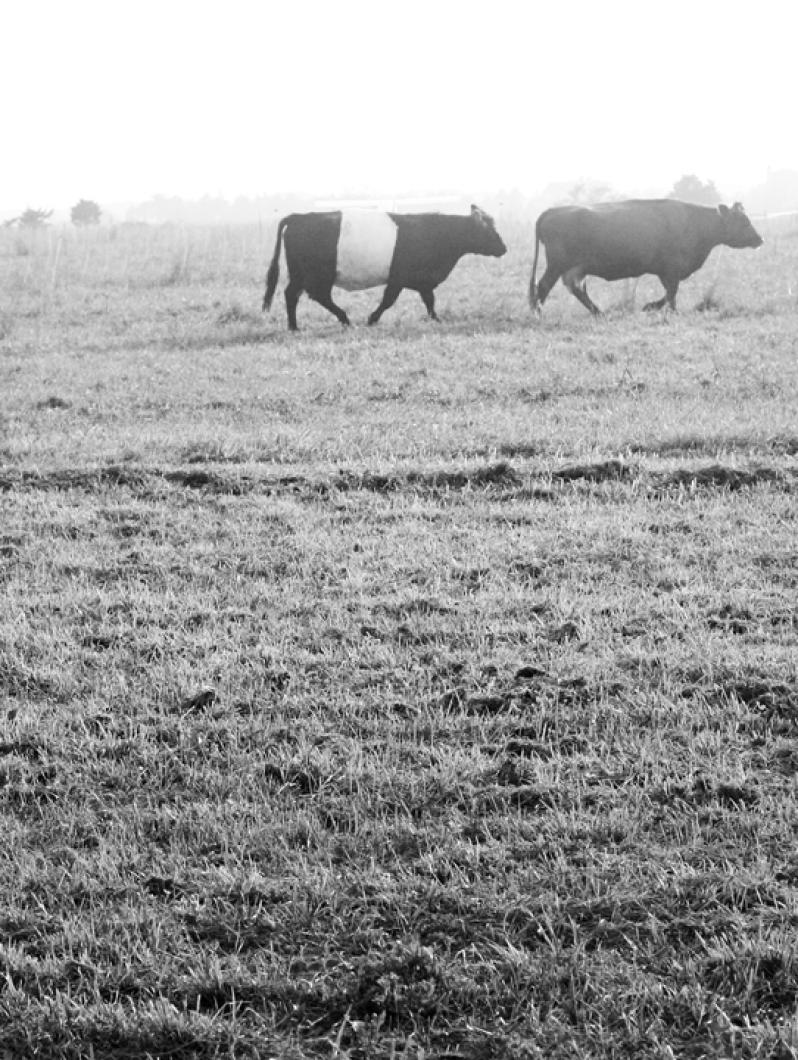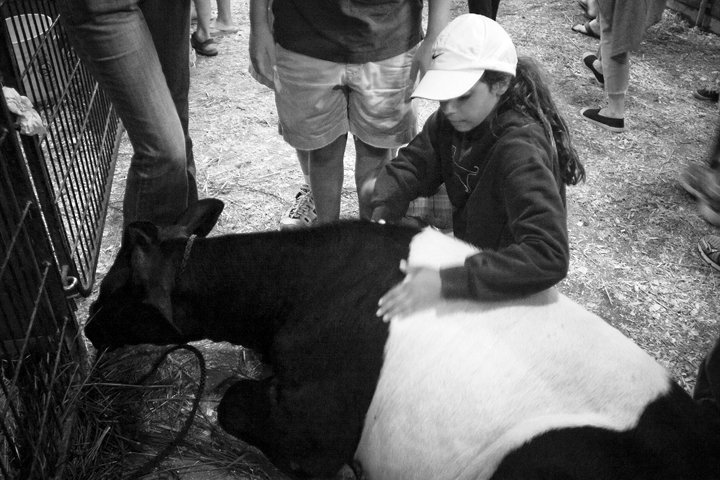Fresh corn, tomatoes, potatoes, squash, greens and other veggies dot the farmers’ markets across the Island. Nothing compares to farm fresh eggs, sometimes you’re even able to buy Island-raised beef, and most recently locally raised and slaughtered poultry. But what about melt-in-your mouth mozzarella made with Vineyard milk, or forgetting the spaghetti and sinking your teeth into a large chunk of Parmesan, maybe even skipping the salad and going straight for the feta?
When it comes to dairy products, Mermaid Farm in Chilmark is the only farm that commercially sells their milk and yogurt. With 12 dairy cows grazing their pastures on Middle Road, Allan Healy is about to expand his dairy production to include something that has been off the Vineyard market scene for nearly 40 years: Island cheese is making a comeback.
“Come on Sally,” Mr. Healy said pulling one of his cows out of the milking room to a nearby field yesterday morning. Some of Mr. Healy’s cows are stubborn, and it’s a struggle every morning to move them after milking. Mr. Healy is out the door by 5:30 a.m. at the latest, setting up the milking machines and attending to other needs on the farm; in addition to dairy, Mr. Healy and his wife, Caitlin Jones, grow a variety of produce that they sell at their stand at the end of the road and at the West Tisbury Farmers’ Market.
“I get 16 or 17 gallons a day and I only do 40 bottles,” Mr. Healy said of milking his cows twice a day. “We sell out regularly, especially during the summertime.”
Mr. Healy has been selling raw milk for five years, which some say is better than pasteurized milk because it doesn’t kill off all of the natural nutrients that are reduced through the pasteurization process. While heating milk to 161 degrees Fahrenheit eliminates harmful diseases, according to Northeast Organic Farming Association it also can reduce vitamins A, B6, B12, C, D, E and F between 50 and 66 per cent.
But in order to make his creamy thick yogurt, Mr. Healy does have to pasteurize the milk, fill the quart-sized container without touching it, and then incubate the yogurt for eight hours. Yogurt brings in a large margin of Mr. Healy’s profit during the year, helping him to break even. He said he might start doing nonfat yogurt by skimming the cream off the milk, broadening his market a bit. But with new cows as of last week, Mr. Healy will be able to use his yogurt room for a cheese room.
“I’m thinking feta and mozzarella to go with our tomatoes,” he said. “I’m going to expand my license to allow me to make cheese I’m excited.”
It will take Mr. Healy nearly five hours to milk all of the cows when he is in full production, something he says isn’t easy to balance between other farm chores and his family. As a result, Mr. Healy will be working with Jan Burhman at Kitchen Porch to make his cheese.
Ms. Burhman has been making cheese from her own cows for three years now, and has been selling mozzarella and other fresh cheeses at farmers’ markets, Morning Glory Farm, Fiddlehead Farm, Eden Market, and Alley’s farm stand. She holds cheesemaking seminars where people have the chance to learn how to stretch out the curd, lengthening the silly-putty-like curd until it becomes soft and delectable mozzarella.
“People are into it,” Ms. Burhman said earlier this week. “People really learn the value of fresh products, knowing where your milk comes, raw milk for aged cheeses, and learning about a variety from different kinds of milk.”
It takes about 90 minutes from start to finish to heat the curd and then stretch it into the rope-like balls that are available to purchase. Ms. Burhman said she was beginning to make aged cheese as well, and was hopeful that sometime in the future she would have more varieties available.
“Ideally I’d like to have a whole lot more going on. It’s a slow process but it’s going,” she said, adding that she recently had a mixture of goat, cow and sheep’s milk cheese that was amazing. “My dream is there would be a whole group of different farmers here that have different animals and we’re all sharing each other’s milk, turning it into a dairy co-op.”
She emphasized the community organization around cheesemaking, and learning from others was key to promoting good, safe and most importantly tasty cheese. “Whenever I’ve gone to cheese gatherings the most beneficial part is sharing each other’s knowledge and product and comparing the quality of cheese,” she said.
And there are others on the Island that make their own cheese and share the successes (and failures) with each other. Katherine Long makes her own cheese from Mr. Healy’s milk as a hobby; she doesn’t have the permits or the money required to sell commercially.
“I don’t think there’s that much market for the kind of cheese I make for the kind of prices I’d have to charge,” Ms. Long said yesterday of the Parmesan, Romano and Manchego cheeses she makes about once a week. “It’s not a cheep thing to makebut it’s a hobby because you love it.
“It’s just another part of cooking, like bread making,” she said. “I have a refrigerator full of cheese [aging in my basement].”
Come 2010, Ms. Long, Ms. Burhman and Mr. Healy won’t be alone in the cheesemaking industry on the Island. The Grey Barn in Chilmark, formerly Rainbow Farm, will be making cheese as well.
Molly and Eric Glasgow are busy finishing construction on four barns at their farm, one of which will be a dairy creamery that will milk around 25 cows when it’s complete. The Glasgows have three dairy cows now, which they milk for their own consumption, but they are expecting 12 more come November.
“We want to be self-sufficient, so that’s what we think we can carry as far as milk goes,” Mr. Glasgow said. “We’re planning on doing it seasonally, stop milking before Christmas and drying them off. We’ll begin milking in the spring again.”
The Grey Barn will be a certified organic farm once it’s up and running full-time, including the milk, yogurt, butter and cheese they plan to make. In the past, previous owners have used the Grey Barn land for dairy production, and Mr. and Mrs. Glasgow hope to return it to its original purpose.
“Next year all of our milk will be made directly into cheesemaking,” Mrs. Glasgow said. “The first cheese that I’m looking at making is an aged Gouda, it will take a couple years.”
Mrs. Glasgow has spent time studying cheese making from Irish professionals, where the weather is similar to that of the Vineyard and allows for her to compare techniques as a result. Next month she will be working with a French cheesemaker. The Glasgows said they will be using a slow pasteurization system, which doesn’t bring milk to scalding temperatures and allows it to still have some qualities of raw milk.
“I’m really excited to make cheese that represents this region,” she said. “I’m looking at over the next five years or so to make just one cheese and make it really well, and look at what milk the cows give us.”
In addition to four new barns, Mr. and Mrs. Glasgow are restoring the old Campbell and Douglass storefront to be able to sell their products, hopefully year-round. “A lot of what it’s about is offering something to the community,” Mrs. Glasgow explained. “We’re designing it so you can see all the meat drying, the cheesemaking room, walk out to viewing area to see cows being milked and a communal table. It’s all publicly open.
“Eventually I’d like to make more than one cheese but we’ll have to see where it goes,” she added. “We’ll have to see what the milk wants to do.”
And with a special entry class dedicated to cheesemaking on the Island for the 150th annual Martha’s Vineyard Agricultural Society Fair next year, could 2011 be the year of cheese?
This column is meant to reflect all aspects of agriculture and farm life on the Vineyard. Remy Tumin may be contacted at 508-627-4311, extension 116, or e-mail her at rtumin@mvgazette.com.





Comments (1)
Comments
Comment policy »